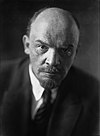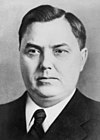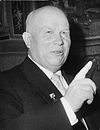Loading AI tools
From Wikipedia, the free encyclopedia
During its 69-year history, the Soviet Union usually had a de facto leader who would not always necessarily be head of state or even head of government but would lead while holding an office such as Communist Party General Secretary. Under the 1977 Constitution, the chairman of the Council of Ministers was the head of government[1] and the chairman of the Presidium of the Supreme Soviet was the head of state.[2] The office of the chairman of the Council of Ministers was comparable to a prime minister in the First World[1] whereas the office of the chairman of the Presidium was comparable to a president.[2] In the ideology of Vladimir Lenin, the head of the Soviet state was a collegiate body of the vanguard party (as described in What Is to Be Done?).
Following Joseph Stalin's consolidation of power in the 1920s,[3] the post of the general secretary of the Central Committee of the Communist Party became synonymous with leader of the Soviet Union,[4] because the post controlled both the Communist Party[5] and, via party membership, the Soviet government.[3] Often the general secretary also held high positions in the government.[6] The post of general secretary lacked clear guidelines of succession, so after the death or removal of a Soviet leader the successor needed the support of the Political Bureau (Politburo), the Central Committee, or another government or party apparatus to both take and stay in power. The President of the Soviet Union, an office created in March 1990, replaced the general secretary as the highest Soviet political office.[7]
Contemporaneously to the establishment of the office of the president, representatives of the Congress of People's Deputies voted to remove Article 6 from the Soviet constitution which stated that the Soviet Union was a one-party state controlled by the Communist Party which in turn played the leading role in society. This vote weakened the party and its hegemony over the Soviet Union and its people.[8] Upon death, resignation, or removal from office of an incumbent president, the Vice President of the Soviet Union would assume the office, though the Soviet Union dissolved before this was actually tested.[9] After the failed coup in August 1991, the vice president was replaced by an elected member of the State Council of the Soviet Union.[10]
Vladimir Lenin was voted the chairman of the Council of People's Commissars of the Soviet Union (Sovnarkom) on 30 December 1922 by the Congress of Soviets.[11] At the age of 53, his health declined from the effects of two bullet wounds, later aggravated by three strokes which culminated with his death in 1924.[12] Irrespective of his health status in his final days, Lenin was already losing much of his power to Joseph Stalin.[13] Alexei Rykov succeeded Lenin as chairman of the Sovnarkom, and although he was de jure the most powerful person in the country, in fact, all power was concentrated in the hands of the "troika" – the union of three influential party figures: Grigory Zinoviev, Joseph Stalin, and Lev Kamenev. Stalin continued to increase his influence in the party, and by the end of the 1920s, he became the sole dictator of the USSR, defeating all his political opponents. The post of general secretary of the party, which was held by Stalin, became the most important post in the Soviet hierarchy.
Stalin's early policies pushed for rapid industrialisation, nationalisation of private industry[14] and the collectivisation of private plots created under Lenin's New Economic Policy.[15] As leader of the Politburo, Stalin consolidated near-absolute power by 1938 after the Great Purge, a series of campaigns of political murder, repression and persecution.[16] On 22 June 1941 Nazi Germany invaded the Soviet Union,[17] but by December the Soviet Army managed to stop the attack just shy of Moscow. On Stalin's orders, the Soviet Union launched a counter-attack on Nazi Germany, which finally succeeded in 1945.[18] Stalin died in March 1953[19] and his death triggered a power struggle in which Nikita Khrushchev after several years emerged victorious against Georgy Malenkov.[20]
Khrushchev denounced Stalin on two occasions, first in 1956 and then in 1962. His policy of de-Stalinisation earned him many enemies within the party, especially from old Stalinist appointees. Many saw this approach as destructive and destabilizing. A group known as Anti-Party Group tried to oust Khrushchev from office in 1957, but it failed.[21] As Khrushchev grew older, his erratic behaviour became worse, usually making decisions without discussing or confirming them with the Politburo.[22] Leonid Brezhnev, a close companion of Khrushchev, was elected the first secretary the same day of Khrushchev's removal from power. Alexei Kosygin became the new premier, and Anastas Mikoyan kept his office as chairman of the Presidium of the Supreme Soviet. On the orders of the Politburo, Mikoyan was forced to retire in 1965, and Nikolai Podgorny took over the office of chairman of the Presidium.[23] The Soviet Union in the post-Khrushchev 1960s was governed by a collective leadership.[24] Henry Kissinger, the American National Security Advisor, mistakenly believed that Kosygin was the leader of the Soviet Union and that he was at the helm of Soviet foreign policy because he represented the Soviet Union at the 1967 Glassboro Summit Conference.[25] The "Era of Stagnation", a derogatory term coined by Mikhail Gorbachev, was a period marked by low socio-economic efficiency in the country and a gerontocracy ruling the country.[26] Yuri Andropov (aged 68 at the time) succeeded Brezhnev in his post as general secretary in 1982. In 1983, Andropov was hospitalized and rarely met up at work to chair the politburo meetings due to his declining health. Nikolai Tikhonov usually chaired the meetings in his place.[27] Following Andropov's death fifteen months after his appointment, an even older leader, 72-year-old Konstantin Chernenko, was elected to the general secretariat. His rule lasted for little more than a year until his death thirteen months later on 10 March 1985.[28]
At the age of 54, Mikhail Gorbachev was elected to the general secretariat by Politburo on 11 March 1985.[29] In May 1985, Gorbachev publicly admitted the slowing down of the economic development and inadequate living standards, being the first Soviet leader to do so while also beginning a series of fundamental reforms. From 1986 to around 1988, he dismantled central planning, allowed state enterprises to set their own outputs, enabled private investment in businesses not previously permitted to be privately owned, and allowed foreign investment, among other measures. He also opened up the management of and decision-making within the Soviet Union and allowed greater public discussion and criticism, along with the warming of relationships with the West. These twin policies were known as perestroika (literally meaning "reconstruction", though it varies) and glasnost ("openness" and "transparency"), respectively.[30] The dismantling of the principal defining features of Soviet communism in 1988 and 1989 in the Soviet Union led to the unintended consequence of the Soviet Union breaking up after the failed August 1991 coup led by Gennady Yanayev.[31]
The following list includes those who held the top leadership position of the Soviet Union from its founding in 1922 until its 1991 dissolution. † denotes leaders who died in office.
| Portrait | Name (lifespan) |
Period | Duration | Congress(es) | Political office | Premier(s) | President(s) | Policies |
|---|---|---|---|---|---|---|---|---|
 |
Vladimir Lenin (1870–1924)[32] |
30 December 1922[32] ↓ 21 January 1924†[13] |
1 year, 22 days | Chairman of Sovnarkom | Himself | Mikhail Kalinin | Leninism • Russian Civil War (1917–23) • War communism (1918–21) • New Economic Policy (1921–28) | |
| After the Russian Revolution, Lenin became leader of the Russian Soviet Federative Socialist Republic (RSFSR) from 1917 and leader of the Union of Soviet Socialist Republics (USSR) from 1922 until his death.[33] | ||||||||
 |
Joseph Stalin (1878–1953)[13] |
21 January 1924[13] ↓ 5 March 1953†[34] |
29 years, 43 days | General Secretary of the Communist Party (1922–1952) Chairman of the Council of Ministers |
Alexei Rykov Vyacheslav Molotov Himself |
Mikhail Kalinin Nikolay Shvernik |
Stalinism • Socialism in one country • Collectivization (1928–40) • Rapid industrialization (1929–41) • Great Purge (1936–38) | |
| Following the death of Lenin, Stalin initially ruled as part of a troika alongside Grigory Zinoviev and Lev Kamenev.[35][34] However, by April 1925, this arrangement broke down as Stalin consolidated power to become the Soviet Union's absolute dictator. He also held the post of the Minister of Defence from 19 July 1941 to 3 March 1947 and chaired the State Defense Committee during World War II.[36] | ||||||||
 |
Georgy Malenkov (1902–1988)[37] |
5 March 1953[38][39] ↓ 7 September 1953[40] |
186 days | — | Chairman of the Council of Ministers |
Himself | Nikolay Shvernik Kliment Voroshilov | |
| After Stalin's death, Malenkov ruled as part of a troika alongside Lavrentiy Beria and Vyacheslav Molotov,[41] Despite initially succeeding Stalin in all his titles and positions, he was forced to relinquish most of them within a month by the Politburo.[42] The troika would ultimately break down when Beria was arrested later that year.[43] Shortly thereafter, he found himself locked in a power struggle against Nikita Khrushchev that led to his removal as Premier in 1955.[44] | ||||||||
 |
Nikita Khrushchev (1894–1971)[43] |
7 September 1953[40] ↓ 14 October 1964[45] |
11 years, 37 days | First Secretary of the Communist Party |
Georgy Malenkov Nikolai Bulganin Himself |
Kliment Voroshilov Leonid Brezhnev Anastas Mikoyan |
Khrushchev Thaw • De-Stalinization (1956–64) • Anti-religious campaign (1958–64) • Sino-Soviet split (1956–66) | |
| In January 1955, Khrushchev emerged as first among equals within the Presidium of the Central Committee by securing Malenkov's removal as its chairman and Premier of the Soviet Union. After nearly being ousted in 1957 by the "anti-party group", he consolidated his power even further by naming himself Premier on 27 March 1958. Ultimately, after alienating colleagues through disruptive shake-ups of the country's infrastructure and brinksmanship on the world stage, he was fired from all his posts at a special meeting of the Presidium on 13 October 1964. | ||||||||
 |
Leonid Brezhnev (1906–1982)[45] |
14 October 1964[45] ↓ 10 November 1982†[46] |
18 years, 27 days | General Secretary of the Communist Party | Alexei Kosygin Nikolai Tikhonov |
Anastas Mikoyan Nikolai Podgorny Himself |
Era of Stagnation • Collective leadership • Kosygin reforms (1965–70) • Brezhnev Doctrine (1968–81) • Cold War détente (1969–79) • 1973 economic reform • 1979 economic reform | |
| In October 1964, Brezhnev replaced Khrushchev as First Secretary of the Communist Party. Despite being the de jure head of the party, he was initially forced to govern the country as part of a troika alongside the Soviet Union's Premier, Alexei Kosygin and Chairman of the Supreme Soviet's Presidium, Nikolai Podgorny. However, by the 1970s, Brezhnev consolidated power to become the regime's undisputed leader. In 1977, Brezhnev officially replaced Podgorny as head of state.[23] At his death in 1982, he received a state funeral. | ||||||||
 |
Yuri Andropov (1914–1984)[47] |
10 November 1982[47] ↓ 9 February 1984†[48] |
1 year, 91 days | — | General Secretary of the Communist Party | Nikolai Tikhonov | Vasily Kuznetsov (acting) Himself | |
| General Secretary of the Central Committee of the Communist Party[25] and Chairman of the Presidium from 16 June 1983 to 9 February 1984.[49] | ||||||||
 |
Konstantin Chernenko (1911–1985)[50] |
9 February 1984[50] ↓ 10 March 1985† |
1 year, 29 days | — | General Secretary of the Communist Party | Nikolai Tikhonov | Vasily Kuznetsov (acting) Himself | |
| General Secretary of the Central Committee of the Communist Party[51] and Chairman of the Presidium from 11 April 1984 to 10 March 1985.[52] However, due to his health and lack of support within the regime, he governed the country for most of his tenure as part of a troika alongside Andrei Gromyko and Dmitry Ustinov. | ||||||||
 |
Mikhail Gorbachev (1931–2022)[53] |
10 March 1985[22] ↓ 25 December 1991[54] |
6 years, 290 days | President (1990–1991) General Secretary of the Communist Party |
Nikolai Tikhonov Nikolai Ryzhkov Valentin Pavlov Ivan Silayev |
Vasily Kuznetsov (acting) Andrei Gromyko Himself |
Perestroika • Glasnost • Uskoreniye • Democratization • New political thinking • 500 Days program (planned) | |
| Served as General Secretary from 11 March 1985[52] and resigned on 24 August 1991,[55][b] Chairman of the Presidium of the Supreme Soviet from 1 October[51] 1988 until the office was renamed to the Chairman of the Supreme Soviet on 25 May 1989 to 15 March 1990[52] and President of the Soviet Union from 15 March 1990[56] to 25 December 1991. Deposed on 19 August 1991, reinstated on 22 August.[57][54] The day following Gorbachev's resignation as president, the Soviet Union was formally dissolved.[58] Gorbachev was the only head of the USSR to have been born during its existence. | ||||||||
On four occasions the Soviet Union was governed by a council known as a troika (i.e."triumvirate"),[59] whereby policymaking depended on the consensus of three chief figures within the Politburo. The instances were: 1) the 2- to 3-year period between Vladimir Lenin's incapacitation and Joseph Stalin's leadership; 2) the three months following Stalin's death;[39] 3) the years between Nikita Khrushchev's fall and Leonid Brezhnev's consolidation of power;[23] and 4) the ailing Konstantin Chernenko's tenure as General Secretary.[60]
| Members (lifespan) |
Tenure | Duration | Notes | ||
|---|---|---|---|---|---|
 |
 |
 |
May 1922[61] ↓ April 1925[62] |
2 years, 11 months | When Vladimir Lenin suffered his first stroke in May 1922, a troika was formed to temporarily rule in his place consisting of Deputy Premier Lev Kamenev, General Secretary Joseph Stalin and Comintern Chairman Grigory Zinoviev. In March 1923, the three assumed permanent control over the country after Lenin suffered another stroke leaving him unable to govern. However, by April 1925, the triumvirate broke up due to Kamenev's and Zinoviev's opposition to Stalin's "Socialism in One Country" policy. After Stalin consolidated power in the 1930s, Kamenev and Zinoviev were ultimately murdered in the Great Purge. |
| Lev Kamenev (1883–1936)[63] |
Joseph Stalin (1878–1953)[13] |
Grigory Zinoviev (1883–1936)[64] | |||
 |
 |
 |
13 March 1953[39] ↓ 26 June 1953[65] |
105 days | After Stalin's death on 5 March 1953, a troika assumed power consisting of Council of Ministers Chairman Georgy Malenkov, Minister of Internal Affairs Lavrentiy Beria and Foreign Minister Vyacheslav Molotov.[41] It dissolved after Beria was arrested and dismissed from the leadership on 26 June 1953.[43] Thereafter, a power struggle ensued between Malenkov and the First Secretary of the Communist Party, Nikita Khrushchev, that ended decisively in the latter's favor by 1955. |
| Lavrentiy Beria (1899–1953)[39] |
Georgy Malenkov (1902–1988)[37] |
Vyacheslav Molotov (1890–1986)[39] | |||
 |
 |
 |
14 October 1964[45] ↓ 16 June 1977[23] |
12 years, 245 days | After Khrushchev's ousting in 1964, he was replaced by a troika comprising Leonid Brezhnev as First/General Secretary, Alexei Kosygin as Premier and CC Secretary Nikolai Podgorny who went on to become Chairman of the Presidium of the Supreme Soviet in 1965. However, as Brezhnev increasingly consolidated power, the triumvirate's effectiveness as a guarantor of collective leadership steadily declined.[66] It was ultimately dissolved in 1977 after Brezhnev took Podgorny's place as head of state.[23] |
| Leonid Brezhnev (1906–1982)[45] |
Alexei Kosygin (1904–1980)[45] |
Nikolai Podgorny (1903–1983)[45] | |||
 |
 |
 |
13 February 1984[67] ↓ 20 December 1984 |
311 days | Despite succeeding Yuri Andropov as the nominal leader of the Soviet Union, Konstantin Chernenko was unable to concentrate policymaking in his hands due to his poor health[68][69] and lack of popularity among the party elite.[70][71] This compelled him to govern as part of a troika alongside Foreign Minister Andrei Gromyko and Defense Minister Dmitry Ustinov.[72] This arrangement lasted until Ustinov's death in December 1984 which made way for Mikhail Gorbachev's rise to power in March 1985.[73] |
| Konstantin Chernenko (1911–1985)[50] |
Andrei Gromyko (1909–1989)[74] |
Dmitry Ustinov (1908–1984)[75] | |||
Seamless Wikipedia browsing. On steroids.
Every time you click a link to Wikipedia, Wiktionary or Wikiquote in your browser's search results, it will show the modern Wikiwand interface.
Wikiwand extension is a five stars, simple, with minimum permission required to keep your browsing private, safe and transparent.